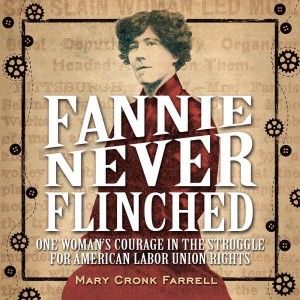Fannie Never Flinched
Fannie Never Flinched
by Mary Cronk Farrell (New York: Abrams Books for Young Readers, 2016)
Book Review by Shanika Carlies, a junior at Brooklyn College who is studying journalism. In her free time, she enjoys spending time with family and friends, reading, and listening to music.
Fannie Never Flinched, by Mary Cronk Farrell, tells the story of Fannie Sellins (1872-1919), a little-known woman labor activist in history who fought until her last breath for the rights of workers during America’s Industrial Revolution. These were the times in American labor history that adults and even young children were forced to work long hours for little pay in the most unimaginable working conditions. Fannie’s story began when she was a garment worker at a sweatshop of the Marx & Haas Clothing Co., in St. Louis, Missouri. She had to work as a widow to support her family. While working in the garment factory, Fannie and her colleagues experienced 10-14 hour workdays, six days a week, in crowded and locked-up rooms. Inspired by the stories of other seamstresses in Chicago and New York City who came together to demand safer work conditions and higher pay, Fannie decided to do the same with her co-workers. Together Fannie and her co-workers in St. Louis organized Ladies’ Local 67 of the United Garment Workers of America, a labor union. The new union proved to be successful by pressuring the bosses of Marx & Haas Clothing Co. to shorten the workday and nearly double the workers’ wages.
Fannie Sellins became president of the UGWA Local 67 and travelled to different cities spreading the word about the terrible working conditions and low pay under the Marx & Haas company, so that people would support the striking garment workers. Through traveling the country and speaking to several unions, Fannie realized that many workers were going through similar situations she went through, like long workdays in terrible working conditions with low pay. Coal miners in Illinois, girl children workers in button factories in Chicago, 10 year old boys working in Detroit cigar factories and union carpenters in Iowa were just a few of the people she met and whose stories were brought to light by traveling across the U.S. to rally support for striking garment workers.
Fannie Never Flinched is intended for young readers between the ages of 11-13. However, this book is suitable for older readers as well. Reading this book is a great way to get an introduction to the passionate role Fannie Sellins had in America’s labor history. The format and design of Fannie Never Flinched has a children’s book look to it. I say this because of the wide pages, and large, easy-to-read text with pictures to accompany almost every page. One thing that really brought the book to life was the primary photos with captions throughout the chapters. Two examples of great pictures are of coal workers with mules and coal miners’ children lined up outside of company housing. The coal workers with the mules looked dirty and exhausted from being in the coal mines most of the day. The children of the coal miners looked pitiful as the background displayed absolute poverty that their families were forced to live in, as company housing was provided to them from the coal company. The captions of these pictures revealed the long hours mule drivers had to work pushing along the carts and how invaluable the humans were compared to the mules. The captions also told where these pictures were taken and in what year. Viewing these photos while reading about Mrs. Sellins’ story saddened me. These workers and children endured such horrible living and working conditions, and most of them were immigrants hoping for a better life in America. Having the photos put a face to the imagination I might have had of what workers’ conditions were like in the Industrial period. The Glossary and Timeline of select events in the American Labor Struggle was useful as well to get more information and context for the events and historical terms mentioned throughout the book.
Like almost everyone, I never heard of Fannie Sellins and her impact until I read this book, so it proved to be very informative. The one thing I was anxious to know more about was her family background and how she grew up. There is information to be had from other sources about Fannie Sellins that provide similar information as this book does. There is a memorial in Pennsylvania dedicated to her. An author’s note explains why there is missing information in the story. Unfortunately, there were some aspects of her life (such as her early life) that were never reported during Fannie’s time. Overall, Fannie Never Flinched was a great book that I honestly enjoyed reading. It was a very educational read for me and will certainly have any young person who gets her hands on it learning about the legacy of Fannie Sellins in labor history. Fannie Sellins proved to be a powerful force in the fight for workers, much so that she was brutally murdered by deputies because of her activism, during a coal miners’ strike in Pennsylvania. Her tireless effort for change in workers’ rights should not be forgotten, as she was a crucial person in the fight for what many workers in the United States benefit from today.

